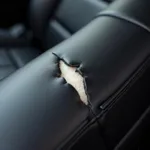Dealing with unsightly scratches on your car’s paint can be frustrating. Fortunately, minor scratches, often referred to as “clear coat scratches,” don’t always require a costly trip to the auto body shop. This comprehensive guide will walk you through the steps to effectively repair light scratches on your car’s paint, saving you both time and money.
Understanding Car Paint Layers and Scratch Depth
Before you begin any repair, it’s essential to understand the different layers of your car’s paint and the depth of the scratch you’re dealing with. Most modern cars have a multi-layered paint system:
- Clear Coat: This top layer provides UV protection and gloss.
- Base Coat/Color Coat: This layer contains the pigment that gives your car its color.
- Primer: This layer promotes adhesion and protects the metal underneath.
- Metal: The foundation of your car’s body.
Light scratches typically only affect the clear coat and are often characterized by a faint white mark. If you can see a different color of paint or bare metal, the scratch is deeper and may require professional attention.
Gathering the Right Tools and Materials
To effectively repair light car paint scratches, you’ll need a few essential tools and materials. Fortunately, these items are readily available at most auto parts stores and online retailers:
- Car Wash Soap and Water: For cleaning the affected area.
- Microfiber Towels: Soft and lint-free for cleaning and drying.
- Rubbing Compound: A slightly abrasive compound to remove the scratch.
- Polishing Compound: A finer compound to restore shine and gloss.
- Wax Applicator Pads: For applying compounds evenly.
- Car Wax: To protect the repaired area and enhance shine.
Step-by-Step Guide to Repairing Light Car Paint Scratches
Follow these steps to effectively repair light scratches:
-
Clean the Scratched Area: Thoroughly wash the scratched area with car wash soap and water. Rinse well and dry completely with a microfiber towel. This removes any dirt or debris that could further scratch the paint during the repair process.
-
Apply Rubbing Compound: Squeeze a small amount of rubbing compound onto a clean applicator pad. Using light pressure, rub the compound onto the scratch in a back-and-forth motion, following the direction of the scratch. Avoid applying too much pressure, as this can damage the paint.
“When using rubbing compound, less is more. It’s always better to start with a small amount and gradually add more if needed,” advises master automotive technician, Mark Stevenson. “Excessive pressure can generate heat and potentially harm the paint, so maintain a gentle touch throughout the process.”
-
Wipe Away Excess Compound: Use a clean microfiber towel to wipe away the excess rubbing compound. You should notice the scratch becoming less visible.
-
Apply Polishing Compound: After using the rubbing compound, apply a small amount of polishing compound to a clean applicator pad. Using circular motions, gently work the polish onto the repaired area. This step will help to restore the shine and gloss to the paint.
-
Buff to a Shine: Using a clean microfiber towel, buff the area until it shines. You should no longer be able to see the scratch.
-
Apply Car Wax: For added protection and shine, apply a coat of car wax to the repaired area, following the instructions on the product label.
Tips for Best Results
- Work in a Shaded Area: Avoid working on your car in direct sunlight, as the heat can cause the compounds to dry out too quickly.
- Use High-Quality Products: Investing in high-quality rubbing and polishing compounds can make a significant difference in the final result.
- Practice Patience: Don’t expect to remove all scratches completely. The goal is to make them less noticeable.
When to Seek Professional Help
While this DIY guide can help you repair light car paint scratches, there are instances where professional help may be necessary:
- Deep Scratches: If the scratch has penetrated the color coat or primer, it’s best to consult with a professional.
- Extensive Damage: For multiple or large scratches, a professional detailer or auto body shop can provide a more comprehensive repair.
- Lack of Confidence: If you’re not comfortable attempting the repair yourself, it’s always best to seek professional assistance.
Conclusion
Repairing light car paint scratches can be a straightforward process with the right tools, techniques, and a bit of patience. By following this guide, you can restore your car’s appearance and protect your investment while saving yourself time and money. Remember, regular washing and waxing can help prevent future scratches and keep your car looking its best.
FAQs
Q: Can I use toothpaste to remove car scratches?
A: While toothpaste contains mild abrasives, it’s not recommended for car paint scratch repair. Toothpaste can be too abrasive and may cause further damage to your car’s paint.
Q: How often should I wax my car?
A: It’s generally recommended to wax your car every three months or so. However, the frequency may vary depending on your car’s exposure to the elements and the type of wax you use.
Q: Can I use rubbing compound on my entire car?
A: While rubbing compound is effective for removing scratches, it’s not intended to be used on the entire car. Excessive use can thin the clear coat and dull the paint over time.
You may also be interested in:
Need more help? Contact us:
We are always ready to assist you with all your car repair needs. Feel free to reach out to our team of experts via WhatsApp: +1(641)206-8880 or Email: [email protected]. We offer 24/7 customer support.

